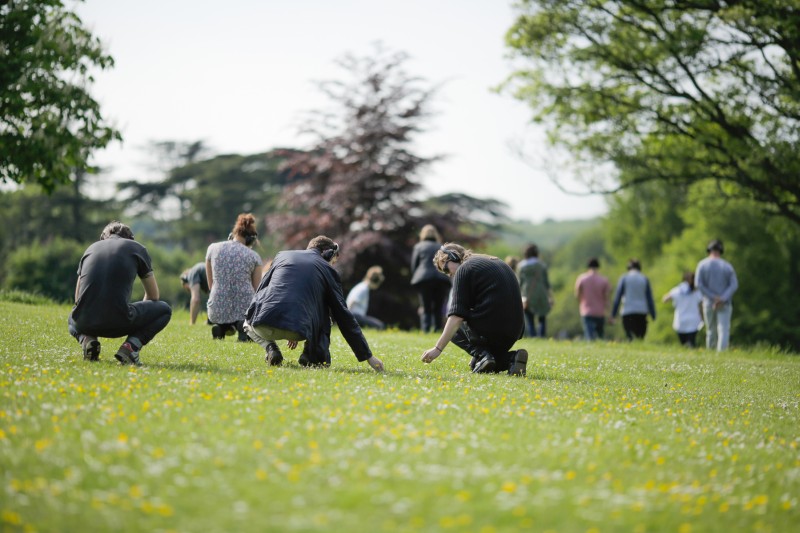 The sun is bright above us as I sit on the grass in Stanmer Park waiting for Walking Stories to begin. We are handed headphones and gathered together as group. There is advice about trusting your instincts, and reassurances that, as you strike out into the open spaces, you will be looked after and you can’t get lost. It’s a carefully thought through opening that gives us a very secure frame for the unchartered territory of this immersive outdoor audio journey. Directed by Charlotte Spencer Projects, and created by a collaborative team of artists, many of them based in Brighton, there is a spirit of hands-on connectedness that permeates the experience: the artists are there with us, handing out headphones and later, walking alongside us.
The sun is bright above us as I sit on the grass in Stanmer Park waiting for Walking Stories to begin. We are handed headphones and gathered together as group. There is advice about trusting your instincts, and reassurances that, as you strike out into the open spaces, you will be looked after and you can’t get lost. It’s a carefully thought through opening that gives us a very secure frame for the unchartered territory of this immersive outdoor audio journey. Directed by Charlotte Spencer Projects, and created by a collaborative team of artists, many of them based in Brighton, there is a spirit of hands-on connectedness that permeates the experience: the artists are there with us, handing out headphones and later, walking alongside us.
Headphones on, our minds are flooded with a changeful soundtrack – a shifting blur of radio programmes and the sound of children in a playground. The sound is so well produced to be dislocating – I keep turning my head to try to see where the children are. Our companions on this journey are to be one another, our small band of fellow audience – at my performance including two children and a very happy dog – and a compelling voice in our ears. We begin to walk.
We are given simple instructions that help us to connect with the people around us – both in our group and in the landscape. Much thought has gone into the rhythm of instructions and ideas, mostly clear and simple enough that the interactions feel comfortable, guarding against self consciousness with room to participate at your own pace. There are small rituals and images created encouraging us to interact with the natural world around us: though I suspect that the ransacking of wildlife in one small area that we conducted as a group at one point wasn’t what the company had in mind. This is participatory choreography: it’s fascinating to observe the movement of bodies around you as meaningful, at the same time as being part of it yourself, a totally different perspective on movement as performance. In an ingenious twist on Klee’s description, our walk is imagined as drawing a line in the environment, encouraging us to perceive our own movements, and those of the group, as artistic interventions and transformations of space. Geometry, rhythms, and momentum all unfold through our own actions, opening out a different way of thinking about your physical relationship to others and to landscape.
The show’s ideas are at their most profound when physical realities overlap with the ideas whispered in our ears: about departures and histories to the disappearing backs of our fellows, about tiny details in the natural world that we notice anew as they are named. Sometimes the ideas feel too abstract for me – about memories in particular – feeling like their connection to his moment, and this form, remain cerebral and not embodied, probably felt all the more sharply because of the very strong resonances established elsewhere. Occasionally the soundtrack’s aural aesthetic also dislocates, not by its play with real sounds that are not here but rather by playing a little too hard against the sounds and atmospheres that are – I loved the trip-hoppy industrial feel of our opening walking track for instance, but it took me out of where we were just when I wanted to be going in.
These are minor niggles though, of a piece that was a rich and mindful experience, as well as being fun and inclusive and genuinely transformative. Here deconstructed and re-presented in an inventive form, this of course is just what great theatre should be!

